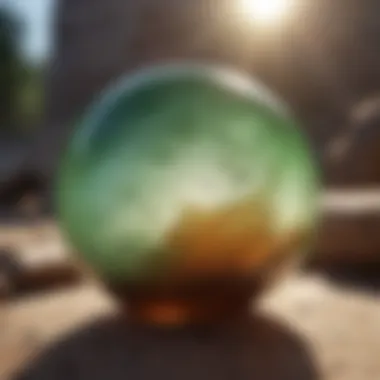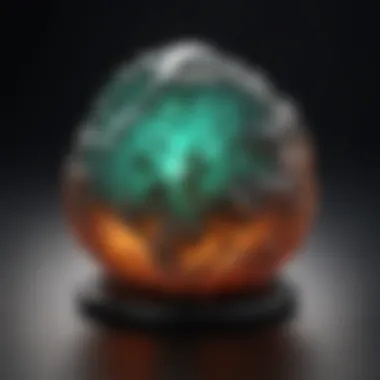Aventurine Identification Guide: Tips for Recognizing this Unique Mineral


Rock and Fossil Identification
Aventurine is a distinctive mineral admired for its shimmering appearance, making it crucial to grasp its unique features for accurate identification. When delving into the realm of aventurine identification, understanding its elaborate characteristics becomes paramount. Key attributes to observe include its color, which ranges from green to peach, due to the presence of fuchsite or hematite inclusions. The shimmer effect known as aventurescence, caused by reflective inclusions within the stone, is a defining trait of aventurine. Additionally, its Mohs hardness of 6.5-7 places it in a specific range among minerals, aiding in its differentiation.
Collecting Tips and Techniques
For rock and fossil enthusiasts keen on adding aventurine specimens to their collection, employing effective collecting techniques is essential. Optimal practices involve researching prime collecting sites renowned for abundant aventurine deposits. These locations often include regions rich in quartz, the primary host rock for aventurine. Upon reaching these sites, safely extracting specimens requires careful handling to prevent damage. Use of appropriate tools like safety goggles, gloves, and chisels is recommended to ensure both personal safety and specimen integrity.
Preservation and Display
Preserving and displaying aventurine specimens play a pivotal role in enhancing their longevity and showcasing their aesthetic appeal. Preservation techniques such as storing specimens in a cool, dry environment and protecting them from direct sunlight aid in preventing deterioration. Utilizing proper storage methods like durable containers or padded trays can safeguard against accidental damage. Creative display ideas include utilizing illuminated shelves or glass domes to highlight the captivating shimmer of aventurine while adding an elegant touch to any collection.
Geological Insights
Delving into the geological facets of aventurine unveils compelling insights into its formation and historical significance. Aventurine forms within igneous rocks through a process of mineral crystallization under specific conditions. Understanding the geological formations that give rise to aventurine sheds light on its rarity and unique properties. Furthermore, exploring notable discoveries of aventurine in geological contexts offers a glimpse into its cultural and industrial importance throughout history.
Introduction
What is Aventurine?


Aventurine is a captivating mineral renowned for its distinct shimmering appearance, making it a sought-after gem among rock and fossil collectors. In the realm of gemology, understanding the essence of aventurine is essential as it holds unique characteristics that set it apart from other minerals. Exploring the origin, composition, historical significance, and varieties of aventurine provides enthusiasts with a deeper appreciation for this mesmerizing gemstone. Aspiring collectors will benefit significantly from unraveling the mysteries behind Aventurine, enhancing their knowledge and appreciation of this remarkable mineral.
Origin and Composition
The origin and composition of aventurine play a pivotal role in its overall allure and aesthetic appeal. Aventurine typically forms within igneous rocks, deriving its distinct shimmer from the presence of reflective mineral inclusions such as mica or hematite. Its composition, primarily composed of quartz and feldspar, contributes to its durability and lustrous appearance. Understanding the geological processes that give rise to aventurine is crucial in discerning its identity and authenticity, adding to its desirability among collectors intrigued by the intricate formations of gemstones.
Historical Significance
Delving into the historical significance of aventurine unveils a rich tapestry of cultural beliefs and mystical associations. Throughout history, aventurine has been revered for its reputed healing properties and symbolic meanings. In ancient civilizations, aventurine was often regarded as a talisman of luck and prosperity, believed to bring abundance and harmony to its wearer. By exploring the historical context surrounding aventurine, collectors gain a deeper insight into the profound impact this mineral has had on human societies and traditions, elevating its value beyond its visual allure.
Varieties of Aventurine
Aventurine exhibits a fascinating array of varieties, each distinguished by unique colors and mineral inclusions that further enhance its beauty. From green aventurine, the most common variety known for its verdant hues, to blue aventurine and peach aventurine, each variant offers collectors a diverse spectrum of colors to appreciate. The presence of different mineral traces imparts distinct qualities to each variety, making the process of identifying and categorizing aventurine an exciting journey for enthusiasts seeking to expand their gemological knowledge. Exploring the various shades and characteristics of aventurine varieties provides collectors with a comprehensive understanding of the breadth and diversity present within this mesmerizing gemstone family.
Physical Characteristics of Aventurine
The section on the Physical Characteristics of Aventurine serves as a pivotal aspect of this article, offering crucial insights into understanding this unique mineral. By delving into the specific elements that define aventurine's physical makeup, readers can develop a profound appreciation for its distinct features. Exploring the color, shimmer effect, clarity, and transparency of aventurine provides a comprehensive foundation for identifying this mineral amidst a myriad of gemstones.
Color


Aventurine's color is a defining characteristic that sets it apart from other gemstones. Known for its green hue infused with shimmering metallic particles, this distinctive coloration adds to its allure and makes it easily recognizable. The color variations in aventurine, ranging from light green to deep emerald, stem from the presence of fuchsite or hematite within the mineral composition. Understanding the nuances of its color spectrum is essential when differentiating aventurine from similar stones, making it a crucial aspect to consider in identification processes.
Shimmer Effect
One of the most striking features of aventurine is its shimmer effect, caused by reflective inclusions of mica or hematite within the stone. This shimmering phenomenon, known as aventurescence, lends the mineral a mesmerizing quality that captures the light and showcases a play of colors. The shimmer effect can vary in intensity and distribution, creating a unique visual appearance that is characteristic of aventurine. Recognizing and appreciating this shimmering quality is key to accurately identifying and appreciating the beauty of aventurine.
Clarity and Transparency
In addition to its color and shimmer effect, the clarity and transparency of aventurine play a crucial role in its overall appearance. Aventurine typically exhibits good transparency with minimal inclusions, allowing light to pass through and enhance its shimmering quality. The clarity of aventurine affects how light interacts with the stone, influencing its visual appeal and value. Examining the clarity and transparency of aventurine provides valuable insights into its quality and enables collectors to differentiate between varying grades of this captivating mineral.
Identifying Aventurine
Visual Inspection
Visual inspection plays a vital role in identifying aventurine, as this mineral showcases distinctive physical characteristics that set it apart from other gemstones. By closely examining the color, shimmer effect, and clarity of the specimen, collectors can determine if it exhibits the typical traits of aventurine. The presence of sparkly mineral inclusions and a unique luster are key indicators that aid in confirming the identity of aventurine. Through a detailed visual assessment, collectors can establish the authenticity and quality of the mineral in question.
Hardness and Density
Assessing the hardness and density of aventurine is essential in the identification process, as these properties provide valuable insights into its composition and durability. Aventurine is renowned for its high hardness, typically ranging between 6.5 to 7 on the Mohs scale, which distinguishes it from softer gemstones and minerals. By conducting hardness tests and density measurements, collectors can further verify the identity of aventurine based on its characteristic physical properties. Understanding these metrics aids in differentiating aventurine from similar-looking minerals and imitations.


Specific Gravity Testing
Conducting specific gravity testing is a precise method for identifying aventurine, as this mineral exhibits a specific gravity ranging from 2.64 to 2.69, depending on its composition. By comparing the specimen's weight in air to its weight in water, collectors can calculate its specific gravity and match it with the expected range for aventurine. This quantitative analysis provides a definitive confirmation of the mineral's identity, allowing collectors to make informed decisions regarding its categorization and authenticity.
UV Light Examination
Utilizing UV light examination is a valuable technique for identifying aventurine, as this mineral often displays unique fluorescence under ultraviolet illumination. By exposing the specimen to UV light, collectors can observe any fluorescent reactions that are characteristic of aventurine, such as a green to orange glow. This diagnostic test serves as a reliable method for differentiating aventurine from other gemstones that may exhibit alternative responses under UV light. Capturing these distinctive fluorescence patterns aids in the accurate identification and classification of aventurine within a rock and fossil collection.
Distinguishing Aventurine from Similar Gemstones
Difference from Jade
When looking at aventurine vs. jade, subtle variations set these two gemstones apart. Aventurine, distinguished by its sparkly appearance due to inclusions of mica or hematite, differs from the smooth, glossy surface of jade. While jade exhibits a range of colors, including green, lavender, and white, aventurine's shimmer typically presents in shades of green and sometimes blue or red. Understanding these visual disparities is fundamental in accurately identifying aventurine and avoiding misclassification with jade.
Contrast with Chrysocolla
Chrysocolla and aventurine, both captivating in their appearance, possess distinct features that help in differentiation. Aventurine's shimmer effect, attributed to its mineral inclusions, differs from the vibrant blue and green hues predominant in chrysocolla. While chrysocolla showcases a striking blue and green color palette with swirling patterns, aventurine's shimmer manifests as sparkling particles within a predominantly green or blue base. Recognizing these contrasting color and visual cues aids in effectively distinguishing between aventurine and chrysocolla.
Comparison with Malachite
A comparison between aventurine and malachite reveals notable differences that assist in accurate identification. Malachite, renowned for its vivid green color and banded patterns, contrasts with aventurine's sparkle and translucency. While malachite showcases intense green hues with dark banding, aventurine's shimmer effect emerges as scattered sparkles against a predominantly green or blue background. By analyzing these contrasting features, collectors can confidently differentiate between these two mesmerizing gemstones.
Conclusion
The importance of the conclusion section in this article is multifaceted. Firstly, it serves as a culmination of the detailed insights and practical tips provided in earlier sections, reinforcing the essential methodologies for identifying Aventurine. Secondly, it emphasizes the relevance of thorough examination and knowledge when it comes to gemstone identification, highlighting the meticulous process required in distinguishing Aventurine from its counterparts. Moreover, the conclusion reiterates the unique allure of Aventurine, showcasing its distinct shimmering quality and how it captivates enthusiasts in the world of rock and fossil collecting.
As readers conclude their journey through this guide, they are equipped with a comprehensive understanding of Aventurine, its defining characteristics, and the nuances involved in accurately identifying this coveted mineral. By synthesizing the information presented in each section, individuals are empowered to confidently spot genuine Aventurine specimens, thereby enhancing their expertise and appreciation for this mesmerizing gemstone.







